|
|
 |
|
Calanoida ( Order ) |
|
|
|
Calanoidea ( Superfamily ) |
|
|
|
Calanidae ( Family ) |
|
|
|
Calanoides ( Genus ) |
|
|
| |
Calanoides philippinensis Kitou & Tanaka, 1969 (F,M) | |
| | | | | | | Syn.: | Calanoides carinatus : Vervoort, 1946 (p.29, figs 1-3) | | | | Ref.: | | | Kitou & Tanaka, 1969 (p.67, figs.F,M); Bradford & Jillett, 1974 (p.9, Rem.); Fleminger, 1985 (p.275, 285, Table 1, 4, figs.F, M, Rem.: A1); Bradford, 1988 (p.77, 78, Rem.); Chihara & Murano, 1997 (p.741, Pl.65: F,M); Mulyadi, 2004 (p.11, figs.F,M, Rem.); Sabatini & al., 2007 (p.360, tab.4, 5); Bradford-Grieve & al., 2017 (p.807, 831, Figs 1, 2, Table 1, 5) | 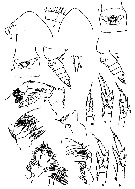 issued from : M. Kitou & O. Tanaka in Oceanogr. Mag., 1969, 21 (1). [p.69, Fg.1]. Female: a-b, forehead (lateral and dorsal, respectively); c, last thoracic segment and urosome (lateral); d, same from another specimen; e, genital segment (ventral)f, same (ventral); g, rostrum; h, A2; i, Md (gnathobase); j, Mx1; k, Mx2; l, Mxp, m, P1; n, P2; o, P3; p, P4; q, P5. Body length of specimens: 2.64 mm (a, c, e); 2.74 mm (b, d; 2.84 mm (f). Nota : Cephalothorx and urosome in the proportonal lengths 81 : 19. forehead triangular in shape, and with a slight chitinous thickening on the anterior (in dorsal view). Rostral filaments slender. Proportional lengths of the urosomal segments and caudal rami 42 : 15 : 13 : 11 : 19 = 100 ; Genital segment nearly as long as width and swollen laterally at the middle section. Genital area protrudes below. Genital opening resembles that of C. carinatus but can be distinguished from that of the latter by differences in structure to some extent. Caudal rami 1.4 times as long as width. A1 extends to the distal margin of the genital segment. A2, Md, Mx1, Mx2, Mxp as those of C. carinatus (Vervoort, 1947). Nota: In the P2 to P4, the exopodal segment 2 is furnished with a group of spinules on the posterior surface (these spinules are also found in the specimens of C. carinatus taken from the Antarctic region).
|
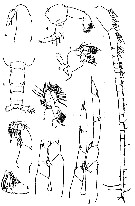 issued from : M. Kitou & O. Tanaka in Oceanogr. Mag., 1969, 21 (1). [p.70, Fg.2]. Male: a, forehead (lateral); b, last thoracic segment and urosome (dorsal); c, right A1; d, A2; e, Md; f, Mx1; g, Mx2; h, Mxp; i, P5 (incomplete); j, P5. Body length of specimens: 2.65 mm (a, b, j); 2.60 mm (i). Nota : Cephalothorax and urosome in the proportional lengths 77 : 23. Forehead evenly rounded (in lateral aspect). There is a small swelling on the dorsal surface just opposite of the place of the attachment of the A2. Proportional lengths of the urosomal segments and caudal rami 16 : 28 : 16 : 14 : 14 : 12 = 100. Caudal rami 1.5 times as long as width. A1 21-segmented, extends to the distal margin of the caudal rami ; proximal segments furnished with long sensory filaments. A2 slightly deformed ; exopod and endopod nearly equal lengths ; exopod 6-segmented and furnished with 4 marginal setae. Md degenerates much ; the cutting edge is provided with a single tooth. Mx1 degenerates ; 1st inner lobe without seta ; 2nd lobe with 1 small pointed lamellous process ; 3rd lobe with 4 short setae. Endopod with 3, 2, 3 setae on the segments 1 to 3. The 2nd basal with 4 setae. The outer lobe with 7 setae. The exopod with 10 setae.Mx2 degenerates in the armature of setae on the lobes. Mxp robust. P5 : exopod 3-segmented, degenerated endopod on each side.
|
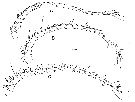 issued from : A. Fleminger in Mar. Biol., 1985, 88. [p.282, Fig.4]. Left A1 (ventral view); A (from 4°05.6'S, 133°34.5E): Male; B, quadrithek female; C, trithek female. Nota: see remarks in Calanus pacificus californicus (Fleminger, 1985) concerning the dimorphism in the female A1.
|
 issued from : M. Kitou & O. Tanaka in Oceanogr. Mag., 1969, 21 (1). [p.72]. Female: Proportional lengthsof the outer margin of the 3rd segment of the exopod divided by the marginal spine in the specimens measuring 2.64 and 2.74 mm. Nota: These datae do not coincide with those for C. carinatus given by Giesbrecht & Schmeil (1898).
|
 issued from : M. E. Sabatini, F. C. Ramirez & J. Bradford-Grieve in Invert. Syst., 2007, 21. [p.361, Table 4]. Comparison characters to distinguish Females C. philippinensis.
|
 issued from : M. E. Sabatini, F. C. Ramirez & J. Bradford-Grieve in Invert. Syst., 2007, 21. [p.361, Table 5]. Comparison characters to distinguish Males C. philippinensis.
|
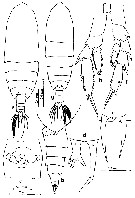 issued from : Mulyadi in Published by Res. Center Biol., Indonesia Inst. Sci. Bogor, 2004. [p.12, Fig.2]. Female (from Indonesian Seas): a, habitus (dorsal); b, urosome (lateral left side); c, genital complex (ventral); d, abnormal rostrum (anterior view); e, rostrum (anterior view); f, P5. Immature female: g, habitus (dorsal); h, P5.
|
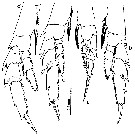 issued from : Mulyadi in Published by Res. Center Biol., Indonesia Inst. Sci. Bogor, 2004. [p.13, Fig.3]. Female: a-d, P1 to P4, respectively.
|
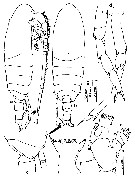 issued from : Mulyadi in Published by Res. Center Biol., Indonesia Inst. Sci. Bogor, 2004. [p.14, Fig.4]. Male; a-b, habitus (lateral and dorsal, respectively); c, angle of last thoracic segment and genital somite (lateral); d, P5 (R : right leg; L = left leg); e, Md (palp); f, Md (mandible blade).
|
 Issued from : V.N. Andronov in Russian Acad. Sci. P.P. Shirshov Inst. Oceanol. Atlantic Branch, Kaliningrad, 2014. [p.73, Fig.19, 5]. Calanoides philippinensis after Kitou & Tanaka, 1969. Male P5.
|
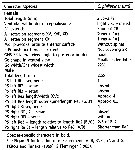 Issued from : J.M. Bradford-Grieve, L. Blanco-Bercial & I. Prusova in J. Nat. Hist., 2017, 51 (13-14) [p.828, Table 5]. Character states distinguished known of Calanoides. A1 = antennule, a = aesthetasc; approx. = approximately; CR = caudal rami; Gns = genital double-somite; Go = genital operculum; ms = modified seta; Pd5 = pedigerous somite 5; P5 = fifth leg; Re = exopod; Ri = endopod; SR = seminal receptacle; St = terminal spine.
|
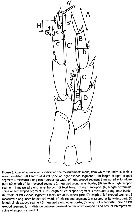 Issued from : J.M. Bradford-Grieve, L. Blanco-Bercial & I. Prusova in J. Nat. Hist., 2017, 51 (13-14) [p.812, Fig. 3]. Calanoides male P5 indicating the measurements made, from which the ratios in Table 4 and 5 were calculated.
| | | | | Compl. Ref.: | | | Fleminger, 1986 (p.84, figs. 3, 4, Rem.); Baars & al., 1990 (p.538: Rem.); Othman & al., 1990 (p.568: Rem.); Arinardi, 1991 (p.292); Lo & al., 2001 (1139, tab.I); C.-Y. Lee & al., 2009 (p.151, Tab.2); Mulyadi & Rumengan, 2012 (p.202, Rem.: p.204); Tseng & al., 2013 (p.507, seasonal abundance) | | | | NZ: | 4 | | |
|
Distribution map of Calanoides philippinensis by geographical zones
|
| | | | | |  Issued from : A. Fleminger inComposite stations of the Siboga Expedition (1899), the Snellius Expedition (1929) and R/V ''Alpha Helix'' Moro Expedition (1979). Issued from : A. Fleminger inComposite stations of the Siboga Expedition (1899), the Snellius Expedition (1929) and R/V ''Alpha Helix'' Moro Expedition (1979).
Stations are indicated by small filled circles, Calanoides philippinensis records by open diamonds, and Rhincalanus nasutus records by a large filled circles.Note how positive records are concentrated off southwestern New Guinea. |
| | | | Loc: | | | Indonesian Seas (Lombok Sea, Flores Sea, Ceram Sea, Arafura Sea, Banda Sea, N Celebes), off E Philippines, Pacif. (W tropical), China Seas (East China Sea), NW & NE Taiwan, SW Korea, SE Japan
Originally described from the Kuroshio Current region (20-30° N) between the northern Philippine Islands region to off southeastern Japan (Kitou & Tanaka, 1969), also recorded from the Banda and Arafura Seas (Arinardi & al., 1990; Baars & al., 1990) and from specimens from the Aru basin (I. Prusova). A species of Calanoides has been recorded off the northwest shelf of Australia (9-14° S) by Tranter (1977) during the southeast monsoon, which may prove to be C. philippinensis. Calanoides , are also recorded off the coast of Western Australia at about 30° S (Stephen, 1998). | | | | N: | 10 | | | | Lg.: | | | (324) F: 2,79-2,55; M: 2,65; (866) F: 2,6-2,8; M: 2,5-2,7; (1122) F: 2,6; M: 2,55; {F: 2,55-2,80; M: 2,50-2,70} | | | | Rem.: | epi-mesopelagic.
May be confounded with C. carinatus; according to Kitou & Tanaka (1969, p.74) the main character separating the two species is the structure of the genital opening females. and in the male by the structure of the mandible blade, 1st to 3rd inner lobes of Mx1 and in armature of the lobes on Mx2, ithe endopod of P5 degenerates in C. carinatus and further in C. patagoniensis which is shown by the absence of setae on the 1st and 2nd segments of the endopod of the right leg; the process of degeneration most goes in C. philippinensis, represented by the complete absense of setae on the endopod of the same leg.
After Mulyadi (2004, p.13) Vervoort (1946) has described the copepodid stages V of female of this species as C. carinatus, based on specimens collected from eastern Indonesian waters. Tanaka's (1937) immature female of this species collected from the deep water of Suruga Bay, Japan, corresponds to Vervoort's (1946) specimen
According to Othman & al. (1990, p.568) can remain in diapause (depth: 300 m) .
For Fleminger (1986) after a cladistic analysis of phylogeny and a biogeographic study, Calanoides supprts the hypothesis that C. philippinensis evolved relatively recently within the Indo-Autralian region and probably at a time when upwelling was much more widespread in this region. Most indo-Malaysian records of Rhincalanus nasutus and C. philippinensis taken by the previous expeditions in Indonesian waters were also obtained from west and south of New Guinea. The author had also found C. philippinensis in this region in surface collections taken off southwest New Guinea in midyeer. Thus, there is ample reason to accept two facts with significant historical implications for Wallacea’s Line :
1 – Upwelling is an annual midyeer event in the southern hemisphere winter prompted by the winter-intensified SE Trade Winds.
2 - C. philippinensis appears to have evolved in the vicinity of Wallacea and probably during a period when the cool water conditions, and the dense phytoplankton populations it favours, were much more extensive than they are now. Compared to the huge populations of its congeners off Africa, South America, South Autralia and the Antarctic, C. pholoppinensis appears to be barely surviving at present.
Extrapolating from available sampling records, C. philippinensis appeazrs to behave as do its allopatric congeners. They tend to enter the mixed layer during seasonal periods of enrichment where they mature and reproduce. Late immature individuals (i.e. stage V copepodids) of the next or some subsequent generation store large quantities of lipids. They leave the mixed layer apparently when food supplies decline presipitously to enter diapause at about 300 to 500 m or deeper.
The diapausing stocks remain as late juveniles at depth until the onset of the next upwelling period as described for Calanoides carinatus and Calanus pacificus californicus (Binet & de Saint Claire, 1975 ; Petit & Courties, 1976 ; Alldredge, 1984). | | | Last update : 09/10/2018 | |
|
|
 Any use of this site for a publication will be mentioned with the following reference : Any use of this site for a publication will be mentioned with the following reference :
Razouls C., Desreumaux N., Kouwenberg J. and de Bovée F., 2005-2025. - Biodiversity of Marine Planktonic Copepods (morphology, geographical distribution and biological data). Sorbonne University, CNRS. Available at http://copepodes.obs-banyuls.fr/en [Accessed October 21, 2025] © copyright 2005-2025 Sorbonne University, CNRS
|
|
 |
 |













